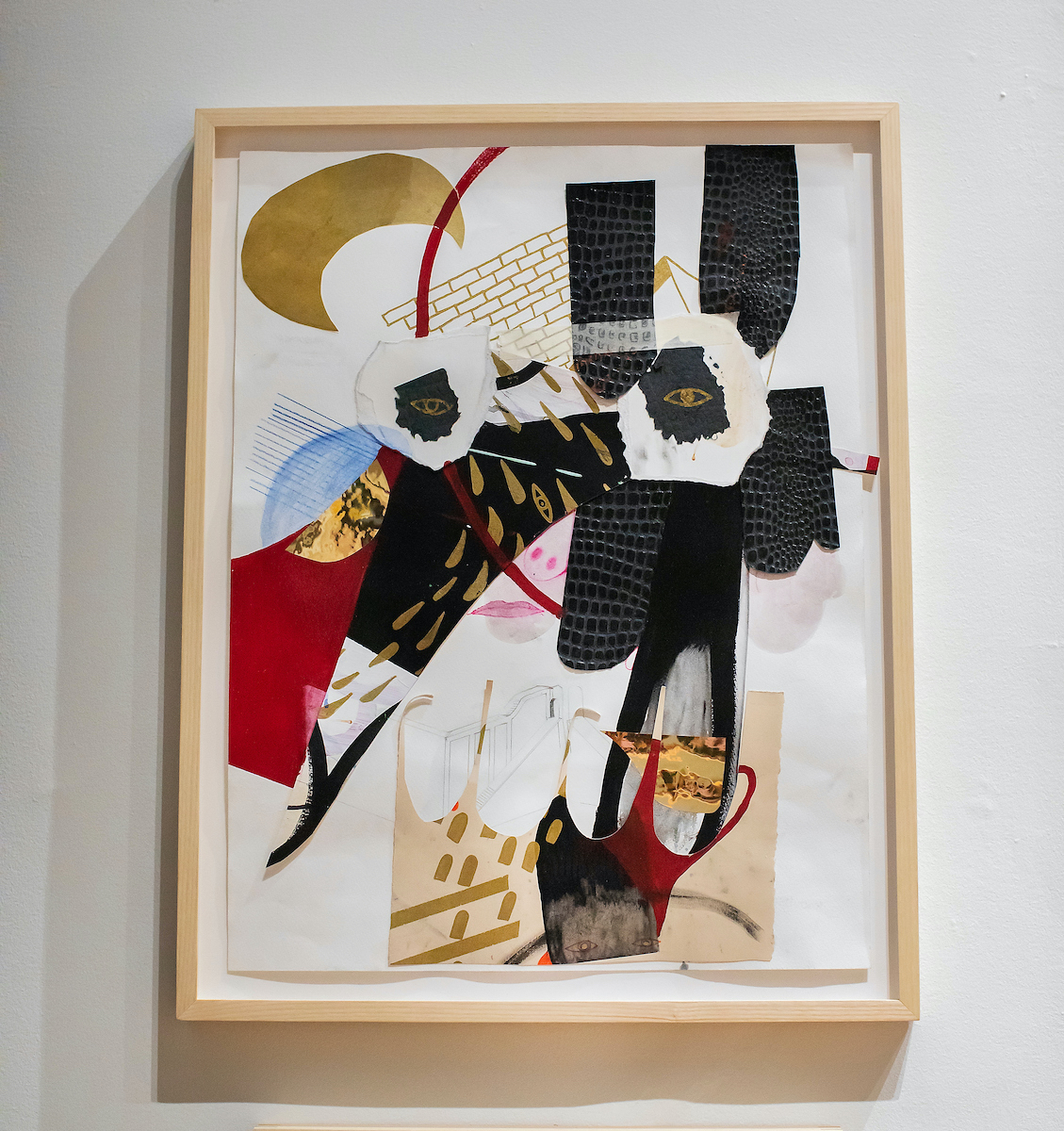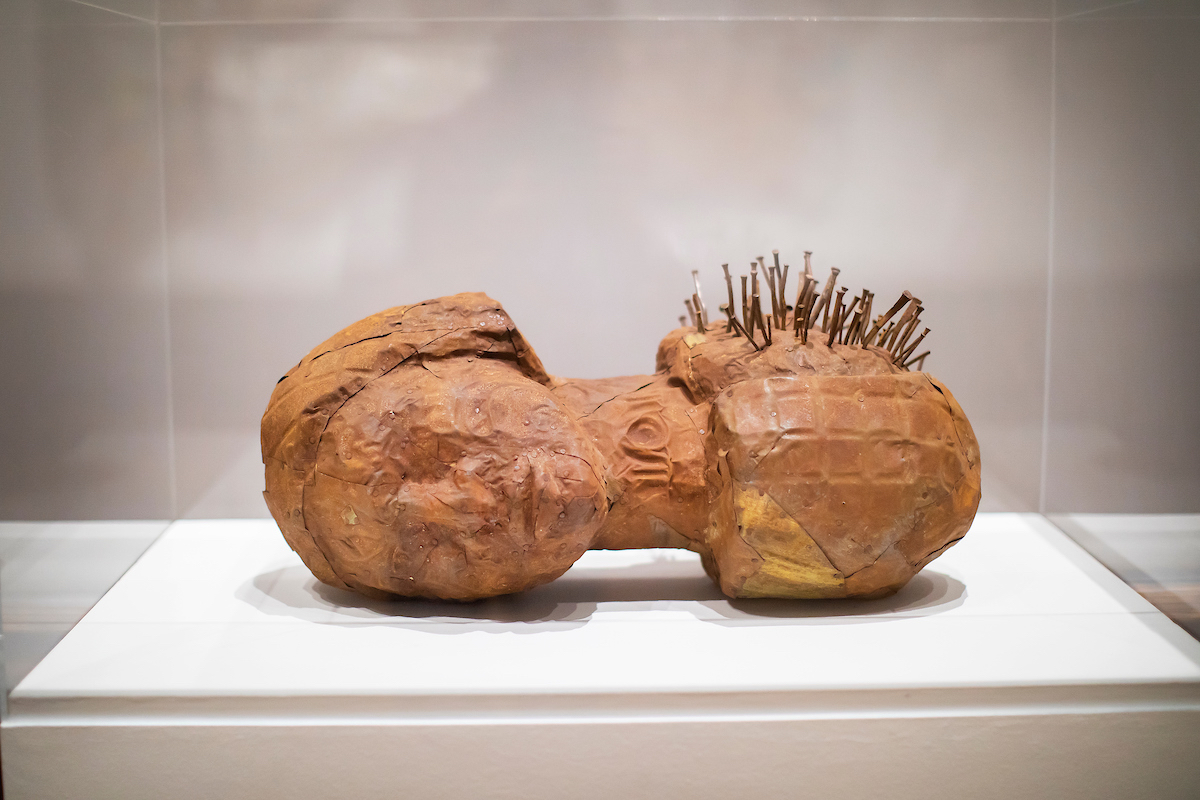Visualizing a New Year’s Mindset
January 11, 2021
[metaslider id=”3044″]
By Heather Moqtaderi, Assistant Director & Curator
How have you adapted this past year? How are you doing? I’m sorry that I can’t literally hear you, but please know that I wish you the best. In the following paragraphs, I offer brief observations on how artworks from the exhibition Re-materialize can help us visualize healthy attitudes about ourselves in the new year.
Under the conditions of COVID-19 social distancing, the past nine months have been a period of radical self-reflection. We have spent unprecedented amounts of time alone with our thoughts, with limited opportunities for healthy in-person socialization. Amidst all of this, I opened Re-materialize, featuring four artists that I admire deeply: El Anatsui, Shari Mendelson, Jackie Milad, and Alison Saar. This was an exhibition that I curated to be experienced in-person, offering opportunity for close looking at materiality through the lens of each artist. Due to the pandemic, the exhibition opened with no celebration, no in-person programming, and very limited in-person visitation. After a brief period of mourning for the experience I had envisioned, I made the best of it by quickly adapting to the digital world and creating virtual opportunities to learn about the artists and artworks. This virtual lens on materiality led me to develop new perspectives on these works based on the conditions of the past year. Below, I highlight four artworks from Re-materialize that offer object lessons on how we can offer ourselves healing, flexibility and growth.

El Anatsui, Sacred Moon, 2007
Found aluminum, copper wire
Mott-Warsh Collection, Flint, MI
Be Flexible, Mend and Move On
El Anatsui is beloved for creating monumental sculptures made from tiny pieces of metal. Anatsui uses aluminum sourced from discarded items such as cassava graters, printing plates, or in the case of Sacred Moon, bottle caps. In each sculpture, these tiny scraps of aluminum are hammered, crimped or folded, and then stitched together with copper wire. It was a thrill to install Anatsui’s work because he invites each gallery to install his sculptures in a way that is unique to their space. Anatsui creates these works with the understanding that they will wear and age over time. When Anatsui’s sculptures arrived for the Re-materialize installation, they were accompanied by a spool of copper wire. The instructions were simple: if a piece fell off, re-attach it. This is a useful attitude that we can extend to our own lives. Imagine yourself as a body made up of a dizzying multiplicity of tiny elements. (Okay, that’s actually true!) Your structural integrity is strong with its own unique character, but you are also flexible. As you find yourself in different spaces and situations, know that you can be flexible while still retaining your essential character. When little pieces detach along the way, just twist on some fresh wire and move on.

Jackie Milad, Little Buildings and Little Walls, 2018
Mixed media on paper
Re-contextualize the Static into Something New
Jackie Milad’s mixed media collages are abstract, but I have come to understand them as portraits. Imagine yourself not as you would appear in a photograph, but as a collage of symbols, textures, and feelings. These elements are tenderly mended together to create the “you” that is inside, peering out at the world. In Re-materialize, two of Milad’s collages on paper hung one-above-the-other: Little Buildings and Little Walls and Arches. These titles suggest the hardness or rigidity of architecture, but the collaged elements are soft and sensual. At the top left of Little Buildings and Little Walls hangs a gold crescent moon, crowning a face defined by torn-paper eyes and unsmiling, hand-drawn pink lips. There is a pattern of golden drops that could be tears or rain, painted on a torn bit of paper that has been salvaged from another work on paper. Milad often repurposes older artworks, cutting or tearing them apart and incorporating them into newer pieces. She isn’t precious about preserving older works of art, but I think of it as an act of love to re-contextualize them in this way – to allow static works to be revived and reinvented. Is there something about yourself that has become static? Sometimes we work hard to achieve things in our lives and preserve them simply because we invested that effort. Milad’s collages are a visualization of honoring past efforts by taking them apart to create something new.

Alison Saar, Janus, 2003
Wood, ceiling tin
Mott-Warsh Collection, Flint, Michigan
Acknowledge the Past and Move Forward
Alison Saar has often alluded to folklore and mythology throughout her prolific artistic output. In Janus, Saar brings together the double-faced Roman god Janus with nkisi n’kondi power figures of the African Congo. Janus, who looks both backward and forward, is traditionally associated with beginnings, transitions, and endings. Nkisi n’kondi are a type of “power figure” used in religious practice to cure illness or amend wrongdoing, and the nails are driven to activate the spirits. What can we make of this powerful “Janus” sculpture of a woman’s head looking in two directions, with one of the faces being punctured in the manner of nkisi n’kondi? From a social perspective, I think about how this past year has shed light on how the history of racism in our country has created an inequitable present. While looking at the past can be painful, it is a necessary part of transitioning to a better, equitable future. Let’s activate our ability to create a better future by acknowledging the past. Acknowledge any privilege that you have and use it to foster a more equitable future.

Shari Mendelson, Sphinx, 2020
Repurposed plastic, hot glue, resin, acrylic polymer, paint, mica
Give Yourself Permission to Be More Than One Thing
Shari Mendelson looks closely at ancient objects as inspiration for her contemporary sculptures. In Crouching Sphinx, Mendelson offers an art object that is both sculpture and vessel, and as a sphinx, a hybrid woman and lion. Mythology is full of hybrid creatures, and Mendelson delights in bringing them to life in her menagerie of sculptural forms. The sphinx itself is a mythological creature that has shapeshifted between cultures. The Greek sphinx is generally presented with a female head on the body of a lion, but the Egyptian sphinx is typically male. The sphinx was adopted in western European neoclassical art, leading to an even more diverse interpretation of the hybrid form in sculpture and decorative art. Mendelson’s sculpture offers a visualization that we can apply to our own self-identity. I think we all feel pressure at times to conform to a fixed or expected identity. In this year of pandemic-induced radical self-reflection, let Mendelson’s sphinx remind you that you don’t need to be one thing in all situations or conform to others’ expectations. Be who you are, wherever you are. If you are a bit of a hybrid, then you are in good company.